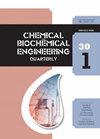聚焦微波辅助加氢蒸馏和超临界二氧化碳萃取1902膜齿苋挥发油的实验动力学模型、表观溶解度和速率常数
IF 0.9
4区 生物学
Q4 BIOTECHNOLOGY & APPLIED MICROBIOLOGY
引用次数: 1
摘要
采用超临界二氧化碳萃取法(SCCO2)和聚焦微波辅助加氢蒸馏法(FMAHD)从粗乙醚提取物中分离褐藻膜齿藻挥发油。通过GC/MS分析挥发物组分,主要化合物为:dictyopterene A、6-丁基1,4-环庚二烯、1-十一碳烯-3-酮、1,4-十一碳二烯-3-酮、(3-氧代十一碳烯-4-烯基)硫、十四烷酸、十六烷酸、3-己基-4,5-二二环庚酮和albicanol。对通过两种工艺获得的挥发性组分的提取进行了动力学研究,允许进行外部校准以量化主要代谢物的含量。应用经验模型调整实验动力学值,同时确定SCCO2的表观溶解度值和FMAHD的速率常数。所获得的结果表明,SCCO2过程的特征是三个不同相共存。对于FMAHD,提取机制包括两个步骤。本文章由计算机程序翻译,如有差异,请以英文原文为准。
Extraction of the Volatile Oils of Dictyopteris membranacea Batters 1902 by Focused Microwave-assisted Hydrodistillation and Supercritical Carbon Dioxide: Empirical Kinetic Modelling Approach, Apparent Solubility and Rate Constants
Supercritical carbon dioxide extraction (SCCO2) and focused microwave-assisted hydrodistillation (FMAHD) were used comparatively to isolate the volatile oils of the brown alga Dictyopteris membranacea from the crude ether extract. The volatiles fractions were analysed by GC/MS, the major compounds were: dictyopterene A, 6-butyl 1,4-cycloheptadiene, 1-undecen-3-one, 1,4-undecadien-3-one, (3-oxoundec-4-enyl) sulphur, tetradecanoic acid, hexadecanoic acid, 3-hexyl-4,5-dithiacycloheptanone, and albicanol. A kinetics study of the extraction of the volatile fractions obtained by the two processes was carried out, an external calibration allowed to quantify the content of the main metabolites. Empirical models were applied to adjust the experimental kinetics values but also to determine the values of apparent solubilities for SCCO2 and the rate constants for FMAHD. The results obtained revealed that the SCCO2 process was characterized by the coexistence of three distinct phases. For FMAHD, the extraction mechanism included two steps.
求助全文
通过发布文献求助,成功后即可免费获取论文全文。
去求助
来源期刊
CiteScore
2.70
自引率
6.70%
发文量
23
审稿时长
>12 weeks
期刊介绍:
The journal provides an international forum for presentation of original papers, reviews and discussions on the latest developments in chemical and biochemical engineering. The scope of the journal is wide and no limitation except relevance to chemical and biochemical engineering is required.
The criteria for the acceptance of papers are originality, quality of work and clarity of style. All papers are subject to reviewing by at least two international experts (blind peer review).
The language of the journal is English. Final versions of the manuscripts are subject to metric (SI units and IUPAC recommendations) and English language reviewing.
Editor and Editorial board make the final decision about acceptance of a manuscript.
Page charges are excluded.

 求助内容:
求助内容: 应助结果提醒方式:
应助结果提醒方式:


